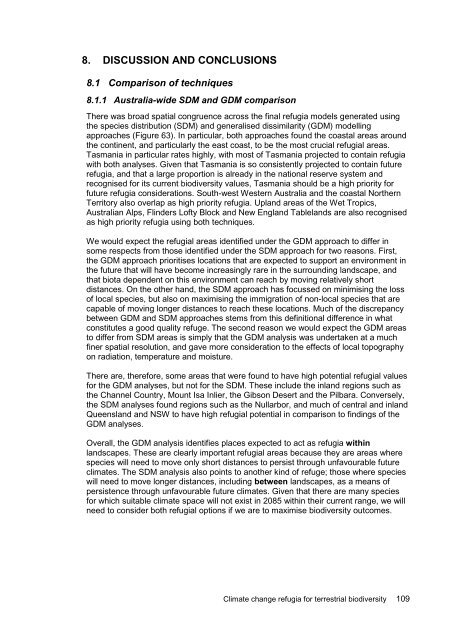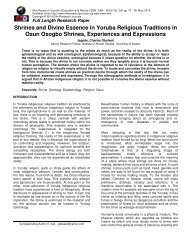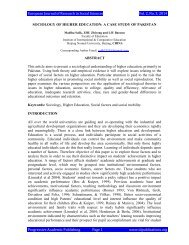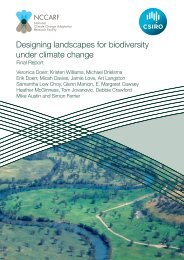Williams-Climate-change-refugia-for-terrestrial-biodiversity_0
Williams-Climate-change-refugia-for-terrestrial-biodiversity_0
Williams-Climate-change-refugia-for-terrestrial-biodiversity_0
Create successful ePaper yourself
Turn your PDF publications into a flip-book with our unique Google optimized e-Paper software.
8. DISCUSSION AND CONCLUSIONS<br />
8.1 Comparison of techniques<br />
8.1.1 Australia-wide SDM and GDM comparison<br />
There was broad spatial congruence across the final <strong>refugia</strong> models generated using<br />
the species distribution (SDM) and generalised dissimilarity (GDM) modelling<br />
approaches (Figure 63). In particular, both approaches found the coastal areas around<br />
the continent, and particularly the east coast, to be the most crucial <strong>refugia</strong>l areas.<br />
Tasmania in particular rates highly, with most of Tasmania projected to contain <strong>refugia</strong><br />
with both analyses. Given that Tasmania is so consistently projected to contain future<br />
<strong>refugia</strong>, and that a large proportion is already in the national reserve system and<br />
recognised <strong>for</strong> its current <strong>biodiversity</strong> values, Tasmania should be a high priority <strong>for</strong><br />
future <strong>refugia</strong> considerations. South-west Western Australia and the coastal Northern<br />
Territory also overlap as high priority <strong>refugia</strong>. Upland areas of the Wet Tropics,<br />
Australian Alps, Flinders Lofty Block and New England Tablelands are also recognised<br />
as high priority <strong>refugia</strong> using both techniques.<br />
We would expect the <strong>refugia</strong>l areas identified under the GDM approach to differ in<br />
some respects from those identified under the SDM approach <strong>for</strong> two reasons. First,<br />
the GDM approach prioritises locations that are expected to support an environment in<br />
the future that will have become increasingly rare in the surrounding landscape, and<br />
that biota dependent on this environment can reach by moving relatively short<br />
distances. On the other hand, the SDM approach has focussed on minimising the loss<br />
of local species, but also on maximising the immigration of non-local species that are<br />
capable of moving longer distances to reach these locations. Much of the discrepancy<br />
between GDM and SDM approaches stems from this definitional difference in what<br />
constitutes a good quality refuge. The second reason we would expect the GDM areas<br />
to differ from SDM areas is simply that the GDM analysis was undertaken at a much<br />
finer spatial resolution, and gave more consideration to the effects of local topography<br />
on radiation, temperature and moisture.<br />
There are, there<strong>for</strong>e, some areas that were found to have high potential <strong>refugia</strong>l values<br />
<strong>for</strong> the GDM analyses, but not <strong>for</strong> the SDM. These include the inland regions such as<br />
the Channel Country, Mount Isa Inlier, the Gibson Desert and the Pilbara. Conversely,<br />
the SDM analyses found regions such as the Nullarbor, and much of central and inland<br />
Queensland and NSW to have high <strong>refugia</strong>l potential in comparison to findings of the<br />
GDM analyses.<br />
Overall, the GDM analysis identifies places expected to act as <strong>refugia</strong> within<br />
landscapes. These are clearly important <strong>refugia</strong>l areas because they are areas where<br />
species will need to move only short distances to persist through unfavourable future<br />
climates. The SDM analysis also points to another kind of refuge; those where species<br />
will need to move longer distances, including between landscapes, as a means of<br />
persistence through unfavourable future climates. Given that there are many species<br />
<strong>for</strong> which suitable climate space will not exist in 2085 within their current range, we will<br />
need to consider both <strong>refugia</strong>l options if we are to maximise <strong>biodiversity</strong> outcomes.<br />
<strong>Climate</strong> <strong>change</strong> <strong>refugia</strong> <strong>for</strong> <strong>terrestrial</strong> <strong>biodiversity</strong> 109






